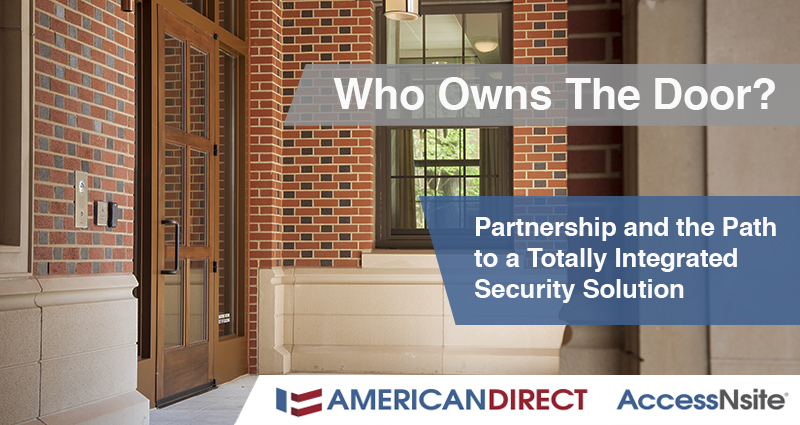
Who Owns the Door?

Let’s be honest, doors can be a real pain.
For each door opening, there are dozens of mechanical and electrified components, specified and sourced from multiple manufacturers. The end product must meet the design, form, and budget of the architect, security consultant, and end user. The general contractor has to coordinate an array of subcontractors, each responsible for a different phase of delivery, installation, and integration — and each with varying levels of experience and expertise. Not to mention the security and IT teams responsible for software implementation, compliance, and ongoing operation and maintenance.
Multiply that by 100 or even 1,000 doors on a project, and it’s not surprising fingers point up and down the supply chain when an issue arises. If an intelligent lock fails in the field, does the end user call the contractor, the manufacturer, the hardware distributor, the commercial integrator, or the electrician?
In other words, “Who owns the door?” Not who owns the lock set, hollow metal frames, software, or security camera. But who, realistically, is going to be the steward, the keeper of the door?
The Game Has Changed
When we started American Direct in 1991 as a contract door and hardware distributor, a door was basically just a door (frame, slab, and hardware), and access control wasn’t much more than locks, keys, and closers.
Today, the door is a dynamic digital ecosystem — intelligent locks, electric strikes, position switches, card readers, video surveillance, bio-metrics, life safety, and more — responsible for aggregating, analyzing, and effectively acting on a rushing river of data. This innovation at the door opening offers the amazing potential to simplify and secure human life, as well as improve a building’s long-term operational efficiency. It also introduces significant new vulnerabilities, including cyber threats and the increasing complexity of the door opening itself.
Of course, this change didn’t happen overnight.
The Challenge of the Channel
In the contract hardware space, we have seen for years the inevitable convergence of the mechanical, electrical, and electronic components of the door opening, prominently marked when the CSI specification for electronic hardware moved from Division 8 to Division 28 in 2016.
For many in the contract hardware space, the dawn of 28/8 created confusion and chaos. For us, it reaffirmed what we already knew: the door opening is inextricably connected with life safety and security.
However, years later, existing Division 28 and Division 8 sales channels are still extremely fragmented, even as product innovation continues to accelerate. Even the most advanced access control solutions are all-too-often initiated with a “low-bidder” mentality, where the physical, electronic, and software solutions are provided by multiple purveyors with varying levels of experience and training.
This disintegrated approach leads to costly mistakes and delays during the project, and extreme frustration for the end user left on the hook after a project is complete. Even more concerning, it endangers the human lives we are responsible for securing.
“Not who owns the lock set, hollow metal frames, software, or security camera. But who, realistically, is going to be the steward, the keeper of the door?”
Starting with Safety and Security
The good news is that we already have at our disposal the advanced technology required to provide efficient and effective security solutions at the door opening. However, in an increasingly complex and digitally interconnected world, we need to think beyond doors, frames, hardware, and even beyond the latest and greatest access control hardware and software. To ensure the ultimate safety and security of a building and its occupants — as well as achieve design, budget, and timeline goals — we must be dedicated to providing total integration of every single facet of every single door opening.
The challenge is that a door opening — and the complete safety and security of a building — is only as strong as its weakest link. As a result, in most cases, failure at a door opening isn’t a mechanical issue, it’s a process issue. Therefore, it is imperative we put safety and security front and center in our work, and that we are relentless in finding opportunities to partner throughout a project.
When access control is treated as an afterthought or add-on, it invariably leads to costly mistakes and frustration for all involved, especially for the contractor stuck in the middle. However, when the end user, security consultant, architect, manufacturer spec team, general contractor, door and hardware contractor, access control provider, and integrator are brought to the table early in the process, we can leverage our collective expertise and experience to collaborate and reduce costs, improve timelines, and deliver a better end result.
Taking Ownership of the Channel
It may sound harsh, but in today’s world, we must innovate or die. Our industry is no exception, and if companies are unwilling or unable to find new ways of providing value to customers, they will not survive the imminent collapse of the existing sales channel.
Fortunately, for those of us willing to embrace this change, we have the opportunity to reinvent the channel to our mutual benefit. That makes each of us — owners, facilities managers, security consultants, IT teams, architects, general contractors, manufacturers, spec teams, software companies, door and hardware contractors, engineers, electricians, and commercial integrators — collectively responsible for owning the door opening.
Ultimately, we are not competitors; we are partners. By dedicating ourselves to ongoing collaboration and the relentless pursuit of innovation on behalf of our clients, we can deliver on the promise of totally integrated safety and security solutions and move our industry forward with greater efficiency, effectiveness, and profitability.




